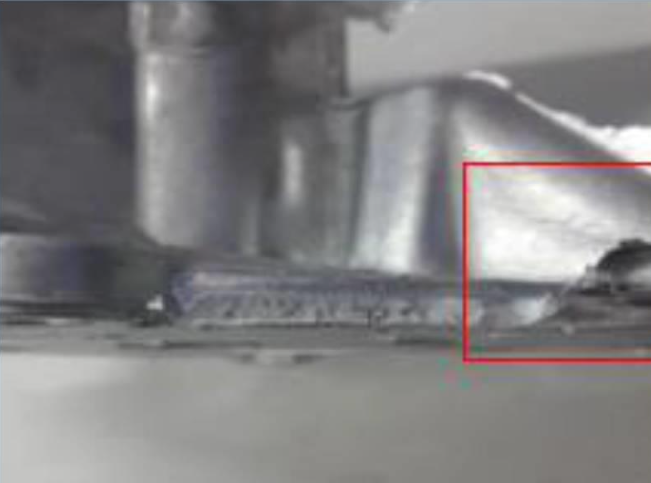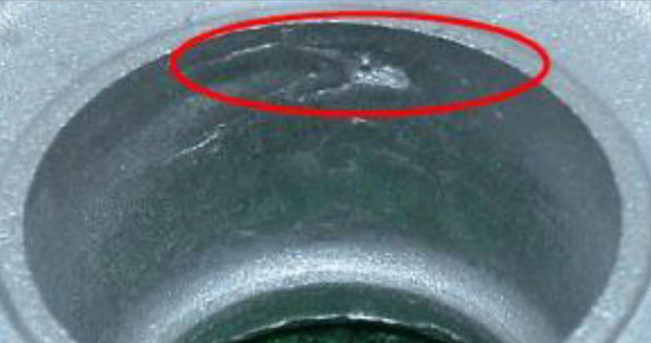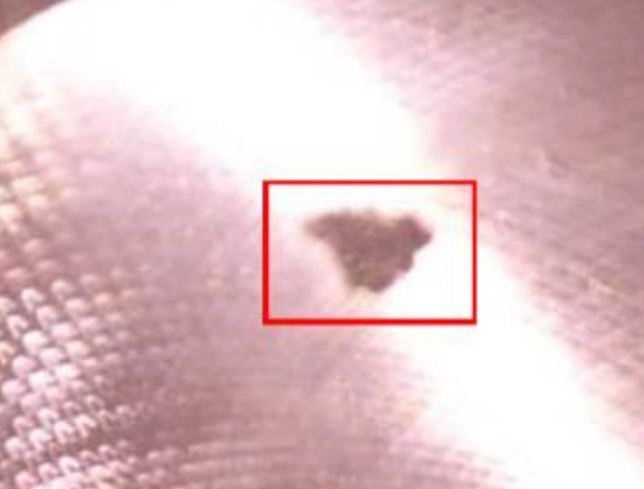1、Cold isolation
Defect phenomenon:
The lower temperature of the metal flow docking each other but not fused and the appearance of the gap, irregular linear, there are penetrating and non-penetrating two, under the action of external forces have a tendency to develop.

Causes:
The pouring temperature of metal liquid is too low or the mold temperature is too low.
Alloy composition does not meet the standard, poor flowability.
The metal liquid is filled in strands, and the fusion is not good.
Unreasonable gate, too long flow.
Low filling speed or poor exhaust.
Low pressure ratio of injection.
The amount of release agent is too much.
Analysis and solution:
The product is black, with flow marks, raise the burning temperature and mold temperature appropriately.
Change the composition of the alloy to improve the fluidity.
Hot mold parts to see the flow direction of the aluminum liquid, the metal liquid collision produces cold partition appears generally vortex, accompanied by flow marks, improve the pouring system, improve the filling direction of the inner gate, in addition, can be set in the edge of the casting slag collection package to improve the filling conditions.
With the distal end of the filling pressure is not solid, change the location and cross-sectional area of the gate, improve the overflow conditions, increase the overflow flow.
The product is dark, often accompanied by surface bubbles, increase the pressure injection speed.
Castings are not solidly pressed as a whole, increase the specific pressure (try not to use).
2、Abrasions & Strains
Defect phenomenon:
Along the direction of mold release, due to metal adhesion, mold manufacturing slope is too small and cause the casting surface strains traces, and in serious cases become strained surface or even produce cracks.

Causes:
The casting slope of the core and wall is too small or inverted slope appears.
Indentation in the core and wall.
Alloy sticking to the mold.
Casting ejection skew or core axis skew.
The surface of the wall is too rough.
Paint is often not sprayed.
The iron content in aluminum alloy is less than 0.6%.
High alloy pouring temperature or mold temperature is too high.
Incorrect pouring system, direct impact on the wall or core.
Filling speed is too fast.
The surface of the cavity is not nitrided.
Analysis and solution:
The product generally pulls out bright marks and does not pile up. Fix the mold to ensure the manufacturing slope.
If hair pulling or even cracking occurs, polish the indentation. Replace the core or weld the wall.
Stretching and hairiness. Polishing the mold.
Large strain on one side, and noise when ejecting. Fix the mold, adjust or replace the ejector bar to make the ejecting force balanced.
Strain as fine streaks, multiple streaks. Polishing the surface.
The surface of the mold is overheated and sticks to the aluminum evenly. The amount of paint is thin and uneven, and the paint should not be missed.
Aluminum alloy adheres to the surface of cavity. Increase the iron content to 0.6%-0.8%.
Aluminum alloy adheres to the surface of the cavity, especially near the inner gate. Lower the pouring temperature and control the mold temperature within the process requirements.
Serious aluminum adhesion on the wall or core. Adjust the position and filling direction of the inner gate.
The inner gate of the mold cavity is severely flushed with adhering alloy. Reduce the speed appropriately.
The cavity surface is often adhered to the alloy. The mold surface must be nitrided.
3、Uncast
Defective phenomenon:
The metal liquid does not fill the cavity, and incomplete filling parts appear on the casting. Mostly found at the end of the casting or narrow deep cavity.

Causes:
Poor alloy flow caused by:
High gas content and oxidation of the metal liquid, resulting in reduced fluidity.
The alloy pouring temperature and mold temperature are too low.
The inner gate speed is too low.
Insufficient nitrogen pressure in the accumulator.
Low pressure chamber filling degree and low specific pressure.
Improper design of the casting wall such as too thin or thick-thin overhang.
Bad pouring system caused by:
Improper selection of gate position, inflow method and number of internal gate strands.
The cross-sectional area of the internal gate is too small.
Bad venting conditions cause:
Poor air venting.
Too much paint, not burned out by drying.
The mold temperature is too high and the gas pressure in the cavity is high, so it is not easy to discharge.
Analysis and judgment and solution countermeasures:
Improve the fluidity of the alloy:
Bad internal quality of the product and many bubbles on the surface. Refine the alloy liquid and exclude gas and non-metal inclusions as much as possible.
Accompanied by cold partition and flow marks. Properly increase the alloy pouring temperature and mold temperature.
Small pits on the surface of the product, cold partition around the under-cast. Increase the pressurized injection speed appropriately.
The pressure gauge has buffering phenomenon and the displayed value does not meet the process requirements, and the casting has the phenomenon of failure to achieve pressure. Replenish nitrogen and increase the effective pressure.
There are traces of cold metal on the surface of the casting, and there are signs of unrealized pressure. Adjust the diameter of the pressure chamber, increase the pressure ratio and adopt quantitative pouring.
There is obvious cold partition or unrealized pressure around the under-cast at the thin wall. River improve the casting structure, appropriate adjustment of the wall thickness, in addition to the opening of auxiliary gates.
Improve the pouring system:
The front end of under-casting is accompanied by cold partition and incomplete fusion. According to the filling simulation or actual hot molded parts, choose the location of the gate, the inflow method and the number of gate strands.
Often accompanied by sticky inner gate phenomenon. Increase the cross-sectional area of the internal gate or increase the pressure injection speed.
Improve exhaust conditions.
The color around the under-cast area is black, accompanied by impurity accumulation and air bubbles, etc. Add overflow groove and exhaust channel, and use top bar gap or core gap exhaust at deep concave cavity.
The surface color is not bright and the flow marks are serious. Use thin and even coating, and close the mold after blowing dry and burning out.
Often accompanied by sticky mold more, serious strain, surface bubbles. Lower the mold temperature to the range specified in the process.
4、Stomata
Defective phenomenon:
Pressure chamber, sprue and cavity in the gas involved in the internal formation of the part shape is more regular, the surface is more smooth hole.

Causes:
The mold temperature is too high and the mold is opened too early.
The filling speed is too high, the metal flow is involved in too much gas.
The paint has a large amount of gas, the amount is too much, not burned out before pouring, so that the volatile gas is wrapped in the surface of the casting, and the other paint contains a large amount of water.
The gas in the cavity is not discharged, and the exhaust is not smooth.
Alloy melting temperature is too high.
Aluminum alloy liquid degassing is not complete, absorbing more gas, which precipitates in the casting when it solidifies
Turbulent flow is generated when filling.
Analysis and judgment and solution countermeasures:
Temperature gun test the surface temperature of the mold, the value shown exceeds the range specified in the process. Lower the mold surface temperature and increase the holding time.
The metal flow pressed into the sprue on the casting surface was obviously much brighter than other parts. The high filling speed is caused by the high pressure injection speed of the equipment itself on the one hand and the thin inner gate on the other. Reduce the pressure injection speed and increase the thickness of the inner gate appropriately.
The way to judge the thinness of the inner gate: whether there is a gate easy to stick phenomenon, reduce the second fast speed to see whether the distal end has a serious pressure does not achieve the image, do not give pressure to hit the parts, see whether there are multiple streams of aluminum liquid.
When spraying, check whether the color of the fog is white, and check whether there is still gas residue in the cavity before closing the mold. Replace the paint or increase the ratio of paint to water.
At the stage of hot mold, there are obvious swirls and paint accumulation on the surface of the casting. Judgment and solution: adjust the open gear, artificially generated up mold, if solved, need to open the exhaust channel.
The metal flow pressed into the inner gate of the casting surface is particularly bright and accompanied by bonding. Reduce the pouring temperature appropriately.
Take sample block to measure density and see if it meets the requirements. Regasification or refining again in the holding furnace.
At the stage of hot mold, the surface of the casting obviously has traces of each stream not dissolving together with the accumulation of paint. Judgment and solution: black oil production, see whether the traces of accumulation, analysis of the accumulation of parts, solutions, a, open or increase the corresponding parts of the slag collection package, b, adjust the internal gate flow direction, location or filling direction.
5、Shrinkage
Defective phenomenon:
Irregularly shaped, rougher surface holes caused by inadequate internal compensation during the condensation process of die castings.

Causes:
High pouring temperature of the alloy liquid.
Uneven wall thickness of the structure of the part, resulting in thermal junction.
Insufficient capacity of the overflow tank and too thin overflow opening.
Excessive amount of mould release agent.
High local temperature of the mould.
Small internal sprue.
Small pouring pressure and slow speed.
Unreasonable composition of alloy liquid.
Analysis and judgement and solution countermeasures:
The local surface of the casting is extra bright. Comply with the alloy melting specification, the alloy liquid superheating time should not be too long, reduce the pouring temperature.
The wall thickness is prone to depression, accompanied by cold separation and pressure failure. In consultation with the customer’s technical engineer, improve the casting structure, eliminate metal accumulation parts, uniform wall thickness and slow transition, without affecting the use of functions. If equipment conditions allow, the use of secondary extrusion is an effective method.
The casting surface has the appearance of pressure failure. Appropriate increase in specific pressure.
Traces of paint and cold metal build-up on the surface of the casting near the spillway. Increase the capacity of the spillway, thicken the spillway and choose the location of the spillway reasonably.
The casting surface is partially laminated and the inner gate section is not compacted and loose. Increase the degree of filling of the pressure chamber, adopt quantitative pouring and control the thickness of the material cake.
The surface of the casting is blackened, not solidly pressed, with cold partition. Improve the pouring system appropriately, increase the cross-sectional area of the inner gate to facilitate good pressure transfer.
Mould temperature gun to check the local area of the mould. Control the local temperature of the mould to reach temperature equilibrium, add points for cooling if necessary. Spray the local high temperature area for a longer time to achieve cooling.
6、Slagging
Defective phenomena:
The presence of fine masses or lumps within the casting matrix with higher hardness than the metal matrix makes machining difficult, and tool wear is severe, often showing hard masses of different brightness on the casting after machining.

Causes:
The alloy is mixed with or precipitated with metal or non-metal substances that are harder than the base metal, such as AL2O3 and free silicon, etc.
A complex compound composed of aluminum, iron, manganese and silicon, mainly formed by MnAL3 in the colder part of the melt pool, then MnAL3 as the core to make Fe precipitation, and silicon, etc. to participate in the reaction to form the compound, free silicon mixed in.
The alloy liquid reacts with refractory bricks and coatings to produce the products.
The metal material is impure and contains other foreign substances. The alloy material adheres to oil and dirt, and the tools are not clean.
Metal hard spots, mixed with undissolved elemental silicon, mixed with raw materials that promote the growth of primary silicon crystals, mixed with substances that generate intermetallic compound crystals.
Partial precipitation hard points. Due to the densification of the acute cold organization, the composition of the easily deviated precipitation is analyzed and becomes a hard point.
The alloy solution is left in the holding furnace for too long.
The alloy liquid in the lower part of the holding furnace has not been cleared for a long time and produces precipitation.
Analysis and judgment and solution countermeasures:
Analysis and judgment: The defect cannot be observed by naked eye because it is inside the casting. In addition, X – light detection can not be identified, only through the processing can identify what nature of the hard spot.
Melting should reduce unnecessary stirring and overheating, keep the alloy liquid pure, when the aluminum alloy liquid is kept in the furnace for a long time, it should be refined and de-gassed periodically, do not scoop the oxide on the surface of the alloy liquid into the spoon when casting, the oxide on the melting tool must be cleared, and the coating on the melting tool cannot react with aluminum.
When aluminum alloy contains titanium, manganese, iron and other groups, should not make the deviation and keep clean, refine with dry refining agent, but when aluminum alloy contains magnesium, pay attention to compensation.
When the aluminum alloy contains more copper and iron, the silicon content should be reduced to less than 10.5%, and the pouring temperature should be increased appropriately to avoid silicon precipitation.
Use refractory bricks and coatings that do not react with aluminum, and replace the furnace lining regularly.
Strictly manage the furnace material, do not allow the mixing of foreign substances or foreign materials, and do not allow oil, sand and dust to stick to the furnace material. The rust and oxides on the tools are removed in time.
Adjust the alloy composition, not directly add silicon elements, to use intermediate alloy. Melting temperature should be high and time should be long, so that silicon is fully dissolved. Prevent the alloy ingot from solidifying the molten alloy when adding material. Minimize the ingredients that promote easy growth of incipient silicon. Reduce the range of temperature fluctuations and do not make the alloy too high or too low. Control the amount of material that produces metal compounds, if any, to be melted at high temperatures. Control the range of temperature fluctuations so that the alloy is in a molten state.
When the alloy is poured into the pressure chamber, it should be filled by pressure injection immediately. As far as possible, do not contain Ca, Mg, Na and other alloy components that are likely to cause acute cooling effect, Ca should be controlled at 0.05% or less.
The alloy liquid placed in the holding furnace for a long time must be pulled out and re-melted, as far as possible, with the use and material.
According to the provisions of the process in time to pull out the lower part of the holding furnace alloy liquid, re-add new alloy liquid.